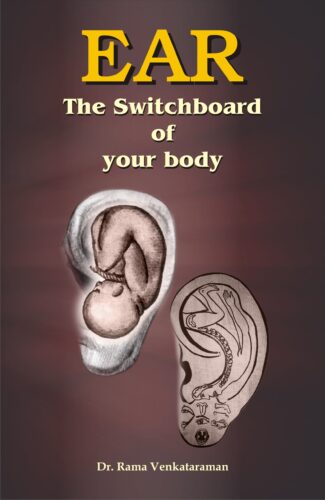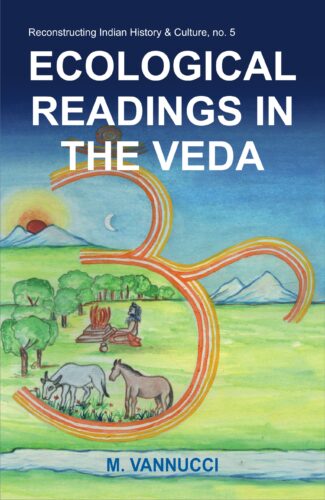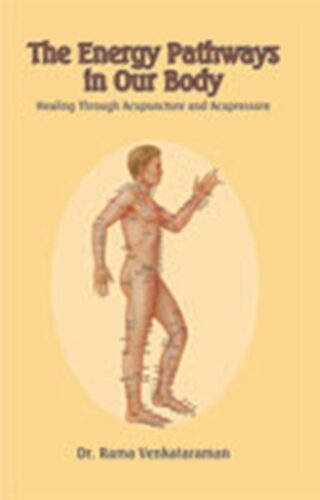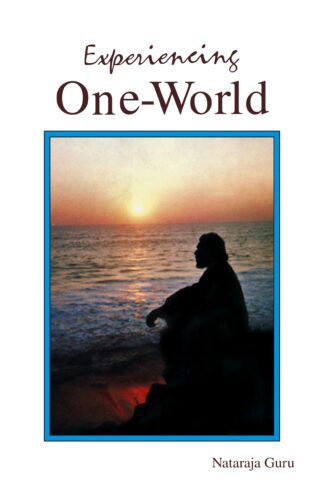Showing 51–60 of 322 results

This attempts to examine how the corresponding ear-points can help in improving the body’s working. It also provides detailed explanations with tables and diagrams of various disorders that can be cured by using the acupuncture methods.
Among the many reflexology parts a human body has, ear is most unique and significant.
Ear is rich in nerve endings and placed at outer rim of the skull, vibrating with energy. In the ear body’s representation corresponds to a child in mother’s womb, curled in an upside down manner. Because of this the ear cure mechanism is also effective in curing problems originated in the womb.
Ear acts like the body’s radar reflecting its working precisely. When these reflex points are activated the sensitive ear nerves carry the return cure reflexes as electromagnetic waves to the organs and body parts, the body responds quickly and diseases are cured.
This is a wonderful effective nature cure through its remote control operation.
This book will serve as a guide to variety of readers especially those interested in traditional medicine and healing systems.
Nature’s gift to mankind.

Dr. Vannucci, exploring the ecological validity of the Vedas, interprets the Vedic verses to decipher the ancient code with a bio-ecological key. She makes a comparative study of Vedic ecology and its contemporary world-view.
The Vedas are indisputably among the oldest of mankinds documents. Which Dr. Marta Vannucci rummages through to address a highly enigmatic question: How man evolved as Man: thinking, discriminating, thought-communicating? Or, yet more specifically, how did he come to identify cause-effect relationships of living-beings: both among themselves and with their environment? In looking for answers, she discovers profound biological, physiological, and ecological insights in Vedic writings which she projects here, with coherent analyses and prolific textual references. Dr Vannucci, who has studied Indian sacred texts for about twenty years, is perhaps the first ever biologist to explore the ecological validity of Vedas. With her critical Florentine mind and five-decade-long involvement in scientific methodologies, she interprets the complex Vedic verses in her thematic effort to decipher the ancient code with a bio-ecological key -spelling out, contextually, the Matter-Energy principles (embodied in Lord Agni) and Life-Hope principles (personified by Lord Savitr). Also setting out a comparative perspective on Vedic expressions of ecology and its contemporary worldview, the author suggests that the essential difference between the two stems not from the perception of reality, but from the manner of their theorizing. It is a painstakingly documented work, with a large-scale glossary of Sanskrit/ technical words and extensive bibliographic references. And also a foreword by a cultural scholar of Dr Kapila Vatsyayans eminence.

Physical postures (asanas) are the most important and often the only constituent of modern Yoga. Many practitioners believe that the postures derive from an ancient original set of eighty-four asanas. This book, for the first time, traces traditions of eighty-four postures by examining original materials, including drawings, descriptions in older Indic texts and modern publications which reflect contemporary traditions. It also takes up a number of broad issues related to the topic of Yoga postures so as to provide the reader with a larger context.
Physical postures (àsanas) are the most important and often the only constituent of modern Yoga. Many practitioners believe that the postures derive from an ancient original set of eighty-four àsanas. This book, for the first time, traces traditions of eighty-four postures by examining original materials, including drawings, descriptions in older Indic texts and modern publications which reflect contemporary traditions. It also takes up a number of broad issues related to the topic of Yoga postures so as to provide the reader with a larger context.

With about 8,000 articles, this Encyclopaedia presents a panorama of Buddhist deities, demigods, godlings, demons the whole range of good and evil forces with the spotlight on the concretized, recognizable forms and their subtle symbolism.
Beginning with a few aniconic symbols, like foot prints, a throne, the Bo tree or stupas, in the prechristian Indian art, Buddhism came to evolve a variety of picturesque representations of a Self-Existent, Superimmanent Principle: in myriad forms and emanations that range from the superbly magnificent to sheerly grotesque. Endowed with diverse iconographic attributes, Buddhist deities/saints/demons have grown, over the rolling centuries, into bewildering numbers, legions. Which all, leave alone the neophytes, not even the best of scholars can recognize! The names of the divinities and their cultural/regional perceptions owing largely to the plurality of Buddhist pantheons, have only gone on to further complicate their identification. Unveiled, for the first time, in the pages of this Encyclopaedia, is a panorama of Buddhist deities, demigods, godlings, saints and demons, with spotlight on the concretized, recognizable forms and the subtle symbolism they involve. In its nearly 8000 alphabetically arranged articles of varying lengths, it mixes gods and demons, bhiksus and btsans, the aesthetic and the grotesque in fact, nearly the whole range of good and evil forces which the inspired among the adherents of the Buddhist faith conceived so ingeniously! Professor Bunce has painstakingly marshalled a wealth of data from authoritative language sources, notably, Sanskrit, Pali, Tibetan, Newari/Nepalese, Chinese, Mongolian, Japanese, Siamese/Thai, Annamese/Viet Namese, Javanese, and Sinhalese, in his effort to capture almost the entire framework of Buddhist divinities: a multi-pantheonic framework, together with its classes, groups and hierarchies, ranging from Adi-Buddha to Arhats and yet beyond. Himself a distinguished scholar of Oriental/Buddhist Art, Dr. Bunce incorporates, in scrupulous detail, the iconographic attributes of deities: like colours, heads/eyes, hands, objects held, body, feet, asanas, mudras, ornaments, vahanas, emanations, and whether calm or wrathful which, with a generous supplement of illustrations: about 300 elegant line-drawings and several colour plates, highlight the distinctiveness of each individual figure. Also included in the Encyclopaedia are users guide, glossaries (of asanas, mudras and attributes), identification charts, a hierarchic table, and bibliographic references. Growing from years of Professor Bunces persevered research and study, this compilation is certainly the first ever to draw together most of the Buddhist divinities/mythological characters, in their distinctly recognizable forms. And is, therefore, indispensable to both the specialists and non-specialists trying to identify each from a whole host of these figural representations.

It studies iconic representations of gods, godlings, demons, witches and tyrants of Hindu mythology, focussing on the concretized form of each pantheonic figure and exploring the iconic language of Hindu images.
Beginning with a few aniconic symbols, like foot prints, a throne, the Bo tree or stupas, in the prechristian Indian art, Buddhism came to evolve a variety of picturesque representations of a Self-Existent, Superimmanent Principle: in myriad forms and emanations that range from the superbly magnificent to sheerly grotesque. Endowed with diverse iconographic attributes, Buddhist deities/saints/demons have grown, over the rolling centuries, into bewildering numbers, legions. Which all, leave alone the neophytes, not even the best of scholars can recognize! The names of the divinities and their cultural/regional perceptions owing largely to the plurality of Buddhist pantheons, have only gone on to further complicate their identification. Unveiled, for the first time, in the pages of this Encyclopaedia, is a panorama of Buddhist deities, demigods, godlings, saints and demons, with spotlight on the concretized, recognizable forms and the subtle symbolism they involve. In its nearly 8000 alphabetically arranged articles of varying lengths, it mixes gods and demons, bhiksus and btsans, the aesthetic and the grotesque in fact, nearly the whole range of good and evil forces which the inspired among the adherents of the Buddhist faith conceived so ingeniously! Professor Bunce has painstakingly marshalled a wealth of data from authoritative language sources, notably, Sanskrit, Pali, Tibetan, Newari/Nepalese, Chinese, Mongolian, Japanese, Siamese/Thai, Annamese/Viet Namese, Javanese, and Sinhalese, in his effort to capture almost the entire framework of Buddhist divinities: a multi-pantheonic framework, together with its classes, groups and hierarchies, ranging from Adi-Buddha to Arhats and yet beyond. Himself a distinguished scholar of Oriental/Buddhist Art, Dr. Bunce incorporates, in scrupulous detail, the iconographic attributes of deities: like colours, heads/eyes, hands, objects held, body, feet, asanas, mudras, ornaments, vahanas, emanations, and whether calm or wrathful which, with a generous supplement of illustrations: about 300 elegant line-drawings and several colour plates, highlight the distinctiveness of each individual figure. Also included in the Encyclopaedia are users guide, glossaries (of asanas, mudras and attributes), identification charts, a hierarchic table, and bibliographic references. Growing from years of Professor Bunces persevered research and study, this compilation is certainly the first ever to draw together most of the Buddhist divinities/mythological characters, in their distinctly recognizable forms. And is, therefore, indispensable to both the specialists and non-specialists trying to identify each from a whole host of these figural representations.

The book speaks about the usefulness and advantages of acupuncture and acupressure therapies. It also attempts to understand the concept of kundalini energy and its association with acupressure.
The Energy Pathways in our Body
Acupuncture and acupressure are drugless therapies that are safe, simple, economical and yet very effective for treatment and prevention of a range of common diseases and ailments. The volume is an attempt to understand acupuncture: its effects and the theory of yin and yang that forms the basis of acupuncture. It examines the causes of diseases and functioning of organs of the body. It discusses the nature of the acupuncture points present in the 14 channels and the way the activation of these points helps in treatment of various disorders in the body. With numerous drawings depicting the various body parts and acupuncture points, it deals with the specific acupuncture points for treating specific tissues. It also notes the symptoms of diseases of different organs.
The book details the advantages of the ancient therapy of acupuncture, especially as it doesn’t have side-effects and can be followed along with other modes of treatment like homoeopathy. There is also an attempt to understand the concept of kundalini energy and its association with acupressure. A list of important instructions for the acupuncture practitioners explains the correct procedures of applying pressure at points. A chapter on case histories mentions successful treatment given to patients with a range of ailments.
The book will be useful to scholars and students of medical science in general but particularly those interested in alternative medicines and medical therapies.

This book presents a panorama of Sri Aurobindos philosophy from different perspectives. It is an enquiry to decide the domain of metaphysics by ensuring its difference from the realm of physics. Its aim is to understand the nature of Sri Aurobindos mystic, yogic, spiritual experience. This is a search for the divine life.
This anthology is a collection of eleven papers written by the distinguished scholars from different parts of India and abroad. This book presents a panorama of Sri Aurobindos philosophy from different perspectives. An endeavour has been made to explain Sri Aurobindos view regarding Integral Metaphysics, the system which accepts the ontology of both material world and consciousness.
This anthology is an enquiry to decide the domain of metaphysics by ensuring its difference from the realm of physics. Its aim is to understand the nature of Sri Aurobindos mystic, yogic, spiritual experience. This is a search for the divine life. It is an attempt to justify the instrumental value of evil as it helps to uplift us from this mundane world atmosphere. It determines the status of evil which is contrary to the Divine God, though emerges from that ultimate Real.
To focus on the aesthetic value of Sri Aurobindos poetic language Essays on Sri Aurobindo has included the discussion of his Savitri. It depicts Sri Aurobindos view about ideal woman who possesses the virtues of care, love, devotion and is also capable to rationally justify her opinion. This book represents his theory of education which emphasizes on learning of application, rather than gathering information. At the same time discussion of his humanistic approach helps us to realize our true self.
As this anthology encompasses different aspects of Sri Aurobindos thought it will satisfy the purpose of the academicians and scholars who are interested to understand his philosophy.

This book focuses on the evolution of philosophy in India with reference to socio-political and economic conditions, through which one can learn that life and thought are invariably interconnected with polity and persons, economy and environment. This book is unique in the sense that it contains a review in the conclusion; and the philosophical heritage has been evaluated in its introduction
In the pattern of Bertrand Russells History of Western Philosophy, this book focuses on the evolution of philosophy in India with reference to socio-political and economic conditions, through which one can learn that life and thought are invariably interconnected with polity and persons, economy and environment. The first chapter demonstrates the socio-political, geographical and racial causes for the formation of human thinking, followed by a chapter on what philosophy is and the nature of Indian philosophy. The Vedas and Upanishads, the Bhagavad-Gita, and about five schools of Vedanta, including Kashmir Shaivism were discussed at length in three different chapters. Another three chapters deal with Carvakas, Jainism and Buddhism; and one on Samkhya and Vaisheshika. This book is unique in the sense that it contains a review in the conclusion; and M.N. Roy has evaluated the philosophical heritage in its introduction. M.N. Roy has remarked that the chapters are of great importance methodologically, and as such constitute the more valuable part of a commendable work of scholarship. It is useful as a reference book for students and scholars as well as general readers interested in understanding the evolution of ancient Indian thought, and broadens the horizons of their knowledge of Indian philosophy.

An eminent exponent of Vedantic philosophy here suggests that the one-world dream could become real if Man learnt to cultivate the unitive vision a one-world consciousness that would tune Man to look towards world fraternity.
Is One World a Utopian ideal? Or just a dream in a world which today, more than ever before, stays riven by parochial, deep-rooted barriers : nationalistic, ethnic, religious, linguistic and many other, leave alone a whole diversity of divisive isms? An eminent exponent of Vedantic philosophy here examines this question afresh to suggest that the one-world dream could become a reality, if Man only learnt to cultivate the unitive vision. Essentially a vital part of Nataraja Gurus globally wide educational programme, Experiencing One-World seeks to evolve one-world consciousness that tunes Man to look beyond the trees to stars, to turn on his mind to world fraternity, and to discern the language of audiovisual arts and the charm of poetry as, for instance, is manifest in the world of architecture and music. Spelling out Nataraja Gurus view of One-World that embraces his long-contemplated perspectives on one-world government, one-world economics, world education, one religion, unified sciences and a language of unified sciences, the book highlights the specialties of well-groomed unitive consciousness of a world citizen, who wishes not only to restructure the existing scheme of things, but also to see mankind live a better life and with dignity.

The 100 inspiring quotes on Faith and Trust address different facets of our relationship within and with external elements. When Trust moves up to a higher helm, an individual transcends apparent limits, discovering new and awesome strengths. Each quote is attuned to a stimulating painting of Lord Ganesha, the Lord of Peace, Prosperity and Wisdom.
Through 100 inspiring quotes on Faith and Trust, the authors address one’s relationship within and with external elements. Each quote is attuned to a stimulating painting of Lord Ganesha, the Lord of Peace, Prosperity and Wisdom. Many wise men and women have worked on this wonderful concept of relationship and brought forth a number of thought-provoking and enlightening quotes for one to relish. The authors have supplemented these great personalities with their own creations.
Relationships cannot take place and sustain without Faith and Trust, be it between individuals, families, friends, organizations, societies, or nations. In simple words, it is the willingness of one party to rely on the actions of another. It is the foundation of all one does in his/her life. Trust self first, then others. From trust emanates team spirit and the capability of delegating responsibilities and powers. When it moves up to a higher helm, an individual transcends apparent limits, discovering new and awesome strengths that one was previously unaware of.
| There are no products |